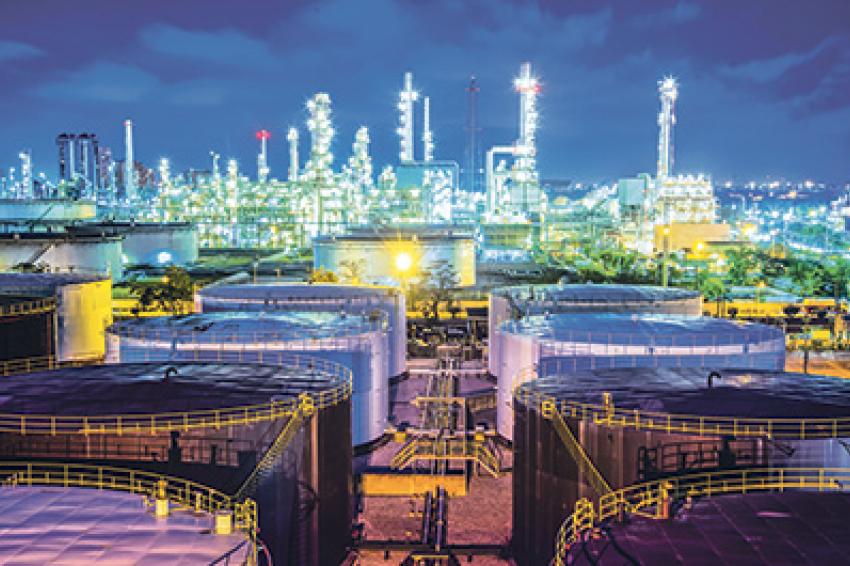Managing Under Pressure
Faster, Safer Designs of Processing Plants in One Environment
Safety is of paramount importance within the petroleum and chemical industries. The aims of safety systems in processing plants are to prevent damage to equipment, avoid injury to personnel, and eliminate the risk of endangering the environment and surrounding community. However, with tight commercial pressures to meet deadlines, every step in the design process is critical to ensure safety and accuracy. Therefore, appropriate sizing, manufacture, assembly, installation and maintenance of pressure-relief valves and rupture disks are critical to achieving optimum protection.
When designing a chemical process and its equipment, safety is a top priority. The main concern for engineers is to plan reliable systems that meet standards while considering safety associated with many diverse types of systems (i.e., pressure vessels, columns, flare stacks, etc.). In particular, over-pressurization of equipment or piping is a major safety concern in a plant.
In order to prevent dangerous bursts, explosions and fires, pressure-relief valves and rupture disks are designed and installed to bleed out excess liquid or vapor causing pressure buildup. Process conditions vary considerably at each location in the process plant where there is a pressure-relief device. Completing a design of a pressure-relief device manually can be a time-consuming and labor-intensive exercise. To solve this problem, cutting-edge engineering software contains relief sizing, which uses process-simulation data to help automate relief-valve and rupture-disk calculations.
Powerful Tools Relieve the Pressure
Engineers are focused on ensuring that all activities carried out at the plant are performed in a safe and controlled environment with particular focus on over-pressure protection, preventing reactor runaway, implementing control schemes and evaluating flare systems. Safety concerns arise from unexpected deviations from predicted behavior, which cannot be explored effectively with traditional steady-state modeling.
Therefore, the engineer always requires a solution that is rigorous, but also easy to use and will not require rebuilding all the existing models. The engineer cannot afford to lose time building models twice and, therefore, needs dynamic software tools to utilize existing steady-state models to evaluate all areas of the plant without wasting funds.
Key priority areas include maximizing safety without over-designing pressure-relief systems, designing control schemes effectively and having reassurance that the tools used meet the industry standard for reliability. Now engineers can perform relief-device design analysis, sizing and documentation from within the process simulation, reducing the time spent to complete overpressure protection studies. Dynamic simulation modeling enhances the precision, capability and credibility to develop realistic and reliable solutions for the actual plant system.
Today, advances and innovation in software both within individual disciplines and also in the integration across the work flow creates tremendous value for many companies, resulting in capital and energy savings, increased safety and reliability, as well as optimized designs with dramatic improvements in engineering quality and productivity.
Many companies have turned to AspenTech for improved safety through better operational procedures, control-system design and proper relief-valve and rupture-disk sizing. AspenONE Engineering is an integrated lifecycle solution from conceptual design through plant start-up and operations support enabling users to model, build and operate safer, more efficient and more competitive process plants. Aspen HYSYS Dynamics and Aspen Plus Dynamics have been successfully used in basic control studies, advanced control studies, operability studies and safety/hazard and operability (HAZOP) studies. Companies are able to meet tighter product specifications through improved understanding of plant operability issues, ensure faster and safer plant start-ups, and avoid unplanned downtimes resulting in maximum plant availability and productivity.
Expanded relief-valve design and rating in Aspen Plus and Aspen HYSYS make the AspenONE solution more comprehensive. New calculations for the fire scenario account for both changes in latent heat in wetted, mixed component vessels over time and changes in relief loads over rising temperatures in unwetted and wetted situations. Rupture disks can now be sized and rated, and multiple-valve configurations can be explored to better design for non-sizing scenarios with smaller relief loads. Adding to prior methods for compliance with API 520 and 521, the software now also provides calculations to comply with the API 2000, 7th edition for the protection of storage tanks.
Reported benefits using dynamic modeling can generate $15 million savings through improved and faster start-up procedures. The avoidance of over-designing relief systems can achieve $10 million in capital cost savings, improved safety through better operational procedures, better control-system design and proper relief-valve sizing, which delivers enormous benefits. Operators can achieve better design decisions through detailed analysis of the trade-offs between process operability and process integration.
Working Faster for Safer Solutions
The measure of any safety-relief system is determined by the robustness of the design. Pressure-relief valves must be designed to protect against all eventualities and should be installed to react to these conditions within the operation.
Pressure-relief device design and sizing can be a tedious, lengthy process. When time is precious, managing under tight timescales requires efficiency. Relief-device sizing with leading-edge engineering software allows the user to design a pressure-relief device quickly using the process information at the location of the valve. The tools can also serve as an accuracy check to ensure that safety equipment has been properly rated and will perform properly, if needed. It helps designers complete their work faster, so that safety equipment can be installed and implemented sooner.
Keeping pace with innovation is essential to remain safe, compliant and competitive. Using dynamic modeling software delivers reliable results, saving time while doing more detailed evaluations and allowing engineers to better simulate potentially hazardous situations, improve design effectiveness and prevent catastrophic equipment occurrences. Equipping engineers with powerful tools relieves the pressure to perform safe, accurate engineering models. It ensures that projects meet standards and that their companies will save equipment, costs and, most importantly, lives.






